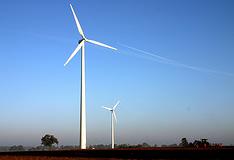Green power, green jobs, renewable energy collide with the Endangered Species Act in a proposed wind farm in Southwest Washington. The project calling for between 48-60 megawatts of power is proposed for 3,359 acres of Washington Department of Natural Resources land northwest of Naselle, Washington. The site, named Radar Ridge, would help utilities in Pacific, Grays Harbor, Clallam and Mason counties meet the requirements of Initiative 397. I-397 mandates that a designated portion of a utility’s power comes from renewable energy sources.
Enter the Marbled Murrelet. The proposed wind farm is in the path Murrelets could use between its feeding grounds in the ocean and nesting areas inland. The Marbled Murrelet has been listed as threatened under the Endangered Species Act since 1992.
In a letter to the Commission of Public Lands, Craig Harrison of the Pacific Seabird Group said, “The lease with Energy Northwest for development of a wind energy project is inconsistent with Washington Department of Natural Resources habitat conservation plan and circumvents federal and state Marbled Murrelet recovery objectives.”
He added, “Furthermore it is inappropriate to develop such a project at this location considering the current status of the species and threats posed to the population.”
The DNR has the power to stop the project if it deems the project endangers Murrelets. The U.S. Fish and Wildlife Service administers the Endangered Species Act but doesn’t have the authority to stop the project. It could, however, stop the windmills from turning if Murrelets are being struck by the blades.
The utilities want the project because it is closer to the customers they serve and it helps them meet the requirements of i-397.
Disclaimer: Articles featured on Oregon Report are the creation, responsibility and opinion of the authoring individual or organization which is featured at the top of every article.


